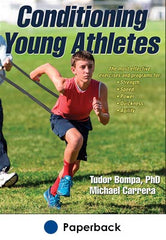Athletic formation stage of development
This is an excerpt from Conditioning Young Athletes by Tudor Bompa & Michael Carrera.
Athletic Formation - 11 to 14 Years of Age
It is appropriate to moderately increase the intensity of training during the athletic formation stage of development. Although most athletes are still vulnerable to injuries, their bodies and capacities are rapidly developing. During this stage, the cardiorespiratory system continues to develop and tolerance to lactic acid accumulation gradually improves.
It is important to understand that variances in individual performance may be the result of differences in growth. Some athletes may be experiencing a rapid growth spurt, which can explain why they lack coordination during particular drills. To account for this, emphasize developing skills and motor abilities rather than performing and winning.
The following guidelines will help an instructor design training programs that are appropriate for the athletic formation stage.
- Encourage participation in a variety of exercises from the specific sport and from other sports, which will help the athletes improve their multilateral base and prepare them for competition in their selected sport. Progressively increase the volume and intensity of training.
- Design drills that introduce athletes to fundamental tactics and strategies and that reinforce skill development.
- Help athletes refine and automate the basic skills they learned during the initiation stage and learn skills that are slightly more complex.
- Emphasize improving flexibility, coordination, and balance.
- Emphasize ethics and fair play during training sessions and competitions.
- Provide all children with opportunities to participate at a challenging level.
- Introduce the athletes to exercises that develop general strength. Athletes should begin developing the foundation for future strength and power during this stage. Emphasize developing the core sections of the body - in particular the hips, lower back, and abdomen - as well as muscles at the extremities - shoulder joints, arms, and legs. Most exercises should involve body weight and light equipment, such as medicine balls, resistance bands, and light dumbbells. Refer to chapter 7 for multilateral strength programs.
- Continue developing aerobic capacity. A solid endurance base will enable athletes to cope more effectively with the demands of training and competition during the specialization stage.
- Introduce athletes to moderate anaerobic training, which is new to athletes in the athletic formation stage. This will help them adapt to high-intensity anaerobic training, which takes on greater importance in most sports during the specialization stage. Athletes should not compete in events that place excessive stress on the anaerobic lactic acid energy system, such as the 200-meter sprint and 400-meter dash in track and field. They are usually better suited for short sprints of less than 80 meters, which involve the anaerobic alactic energy system, and endurance events of longer distances (e.g., 800 meters and longer) at slower speeds, which test aerobic capacities.
- Avoid competitions that place too much stress on the body. For example, most young athletes do not have sufficient muscular development to perform a triple jump with the correct technique. As a result, some may experience compression injuries from the shock that the body must absorb somewhere during the stepping and hopping segments of the jump.
- To improve concentration, introduce athletes to more complex drills. Encourage them to develop strategies for self-regulation and visualization. Introduce formalized mental training.
- Introduce athletes to a variety of fun competitive situations that allow them to apply various techniques and tactics. Young athletes like to compete; however, it is important to de-emphasize winning. Structure competitions to reinforce skill development. For example, base the objective of a javelin-throwing competition on accuracy and technique rather than on how far athletes can throw the javelin.
- Provide time for play and socializing with peers.
The fast improvement in coordination that occurs during prepubescence sometimes slows or even slightly regresses during pubescence. Growth spurts of up to four or five inches (10-12 cm) per year, specific to this stage of children's development, normally occur with disturbances in coordination. This is mostly because limb growth, especially in the legs, changes the proportions between body parts and their leverage and, consequently, the ability to coordinate their actions proficiently.
Although these trends are evident in all children, those who practice sport continue to gain in the quality of coordination compared with those who do not. During pubescence, balance and the accuracy and timing of physical actions continue to improve in these children. Girls tend to improve visual orientation and rhythm of motions better than boys because of sex differences and because girls have a more natural talent for dance and artistic sports.
Differences in coordination abilities are also visible between early- and late-maturing children. Early maturers go through a slight coordination crisis, which may temporarily affect the fine coordination of physical actions (Sharma and Hirtz, 1991). Consequently, because of their fast rhythm of physical growth, early maturers need more exercises for coordination improvement than do late maturers. The key is to introduce a variety of exercises that require balance, changes in rhythm, and spatial orientation. The athletes should feel that they are in control of the exercise if improvements are to be made. Choosing exercises that are too easy or too difficult for the athletes will stunt progress. The best program for improving coordination includes a variety of exercises and games that are at the skill level of the individual athletes or groups of athletes.
Learn more about Conditioning Young Athletes.
More Excerpts From Conditioning Young Athletes

Get the latest insights with regular newsletters, plus periodic product information and special insider offers.
JOIN NOW


